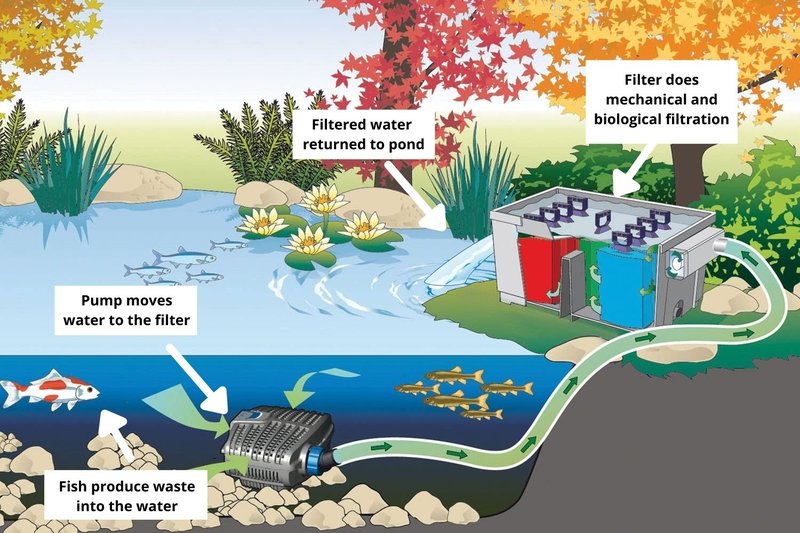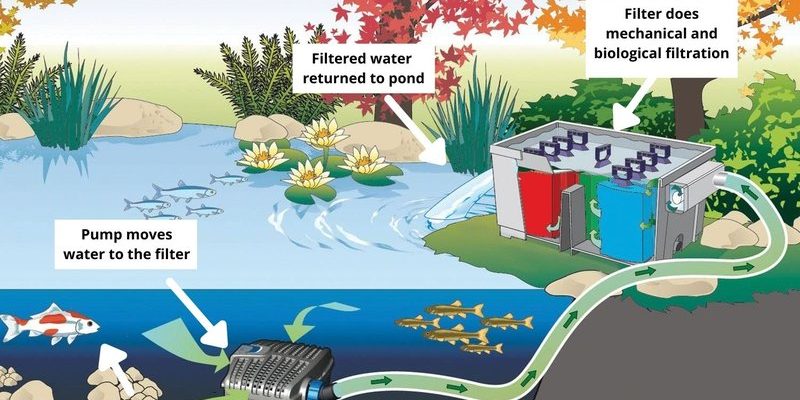
When considering a filtration system, it’s essential to think about the types of fish you have and the size of your pond. Some systems focus on mechanical filtration, while others may emphasize biological processes, essentially creating a mini-ecosystem. Brands like Aquascape and Oase offer various options tailored for different pond needs. But how do you choose? Let’s break down the different types of pond filtration systems to find the best match for your aquatic companions.
Understanding the Basics of Pond Filtration
Before we jump into specific types of filtration systems, it’s crucial to understand what filtration does. Think of this as the “lungs” of your pond. Filtration systems help remove debris, excess nutrients, and harmful bacteria, keeping the water clear and healthy. There are three primary types of filtration: mechanical, biological, and chemical.
– Mechanical filtration is like a net that catches leaves and debris floating on top of the water.
– Biological filtration works with beneficial bacteria to break down toxic ammonia and nitrites, which are harmful to fish.
– Chemical filtration uses substances like activated carbon to remove impurities and odors.
The best filtration system for your pond often involves a combination of these types, creating a balanced environment for your fish.
Mechanical Filters: The First Line of Defense
Mechanical filters are essential for removing visible debris from the water. They work by drawing pond water through a mesh or foam material, trapping dirt, leaves, and other particles.
You might be wondering what benefits a mechanical filter offers. Firstly, they help maintain a clean and inviting pond, preventing algae blooms and enhancing the overall appearance. Just imagine looking into your pond and seeing crystal-clear water instead of a sludge-filled mess.
When choosing a mechanical filter, consider its size. A filter that’s too small for your pond will struggle to keep up, leading to poor water quality. Popular choices include pressure filters or pond skimmers that remove leaves before they sink.
Biological Filters: The Hidden Heroes
Now, let’s chat about biological filters. Think of them as the unsung heroes of your pond’s ecosystem. These filters use beneficial bacteria to break down harmful waste products that can build up over time. This process is called biofiltration, and it’s essential for maintaining water quality.
When fish produce waste, it releases harmful substances like ammonia into the water. Biological filters convert these toxins into less harmful compounds through a natural process. This means healthier fish and less frequent water changes!
It’s also important to understand that biological filtration needs some time to establish. You won’t see immediate results, but with patience, your pond’s ecosystem will thrive. Brands like Tetra and Laguna offer effective biological filters that can handle a range of pond sizes.
Chemical Filters: The Purifiers
Chemical filters might not be the star of the show, but they certainly play a crucial role. They help eliminate specific contaminants from the water, including chlorine, odors, and discoloration. If your pond water has an unpleasant smell or looks murky, a chemical filter can boost clarity and improve the overall health of your pond.
These filters often use activated carbon, which has a massive surface area to absorb impurities. You’ll want to replace the carbon periodically, as its effectiveness diminishes over time.
While chemical filtration is helpful, it shouldn’t be your sole method of filtration. Instead, think of it as a supplement to mechanical and biological filtration, helping achieve that pristine water quality you desire for your fish.
Choosing the Right Size Filter
One of the most common mistakes new pond owners make is choosing a filter that’s too small for their pond. The size of your filtration system should match the volume of water in your pond. If your pond is larger than your filter can handle, you’ll likely experience issues with water quality.
To find the right size filter, calculate your pond’s volume. For a rectangular pond, multiply the length, width, and depth (in feet) and then multiply by 7.48 to get the gallons.
Many filter brands will specify the maximum pond size their filters can handle. For example, if you have a 1000-gallon pond, look for a filter that can effectively manage that volume.
Maintenance Tips for Pond Filtration Systems
Once you’ve set up your filtration system, regular maintenance is key to keeping everything running smoothly. Think of it like taking care of a pet; you can’t just set it and forget it. Here’s a simple maintenance routine to keep things in order:
- Clean Mechanical Filters Regularly: Depending on the amount of debris your pond collects, aim to clean mechanical filters every few weeks.
- Check Biological Filters: Ensure they’re not blocked and allow beneficial bacteria to thrive. Avoid cleaning these filters too often since they need some biofilm to function.
- Replace Chemical Media: Keep an eye on the effectiveness of your chemical filters and replace any activated carbon as needed.
- Test Water Quality: Use water testing kits to regularly check ammonia, nitrite, and pH levels to ensure a healthy environment for your fish.
By following these maintenance tips, you’ll help keep your pond clean, clear, and safe for your aquatic life.
Choosing the right pond filtration system can feel overwhelming, but don’t stress. Start by understanding your pond’s needs and the fish you want to keep. A hydraulic mix of mechanical, biological, and chemical filtration is often the best approach for maintaining a healthy aquatic environment.
Whether you go for a compact pressure filter or a robust biological filter, the key is to match the system to your pond’s size and requirements. Remember, a little investment in a good filtration system today could lead to a thriving pond ecosystem tomorrow.
Just like nurturing a garden, creating the perfect pond takes time and effort, but the joy of watching your fish flourish is well worth it! Happy pond keeping!

